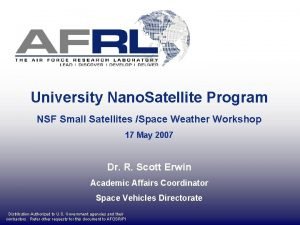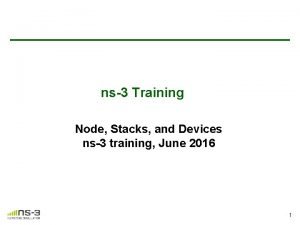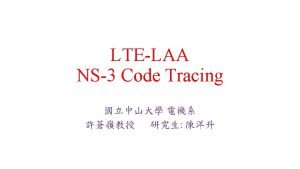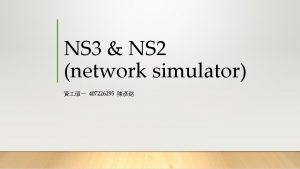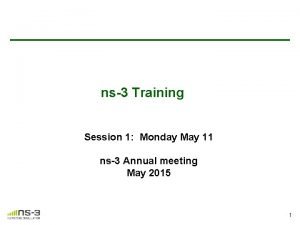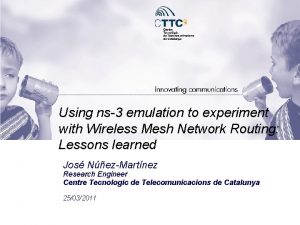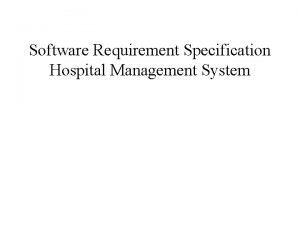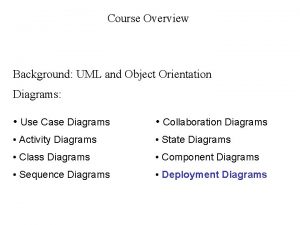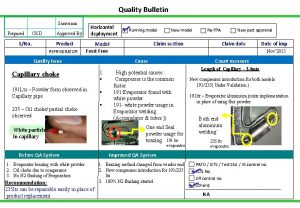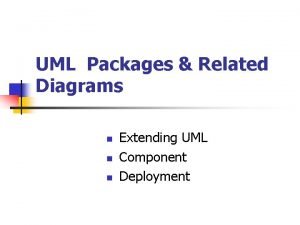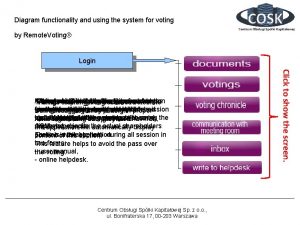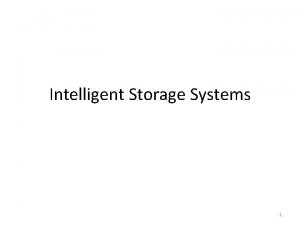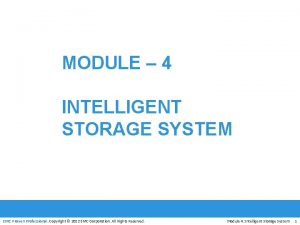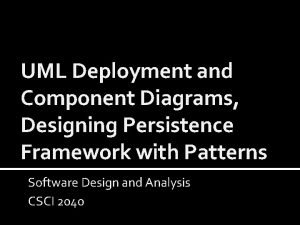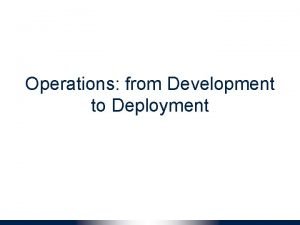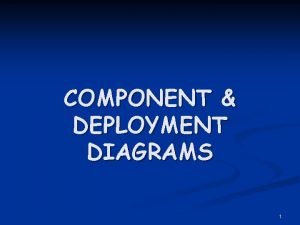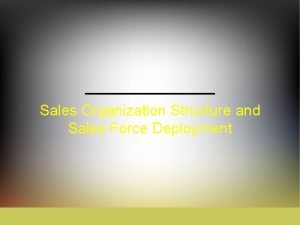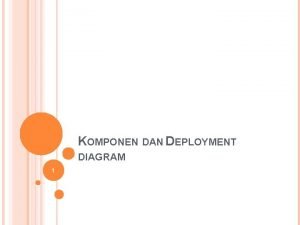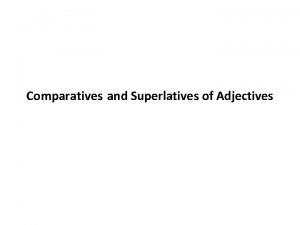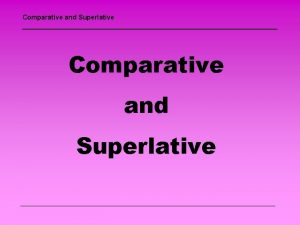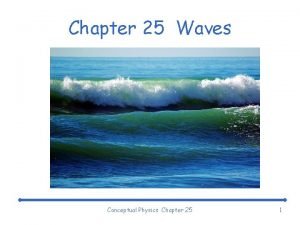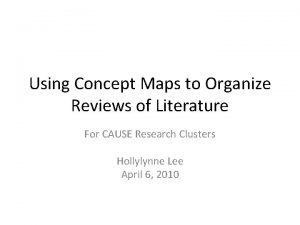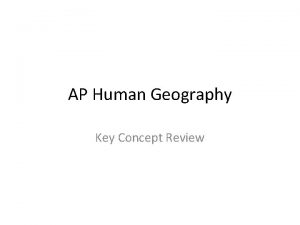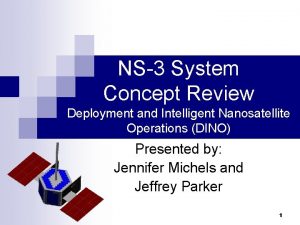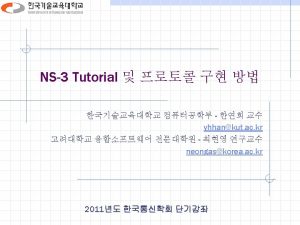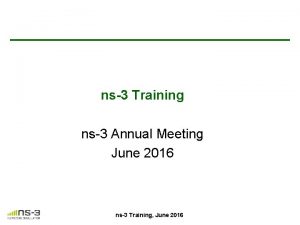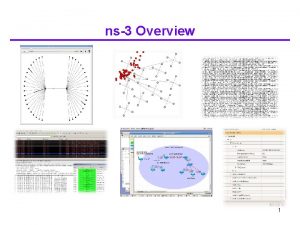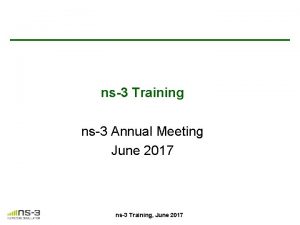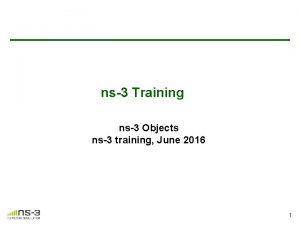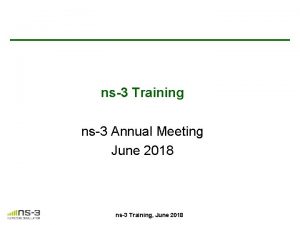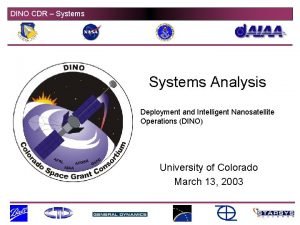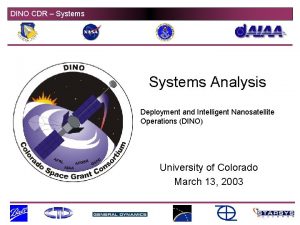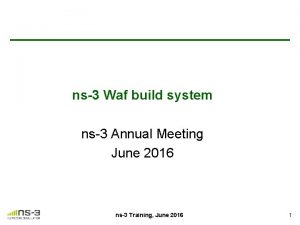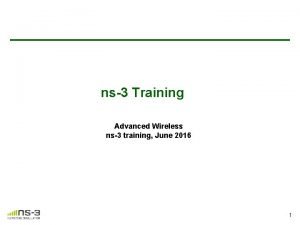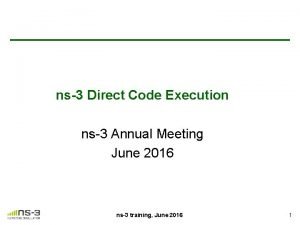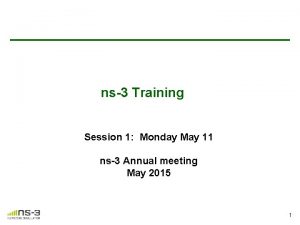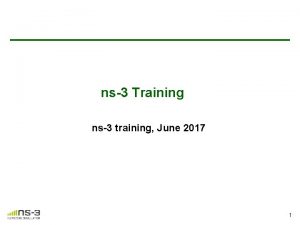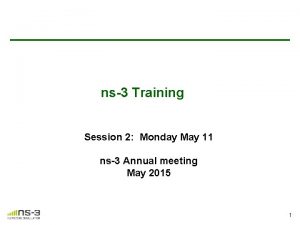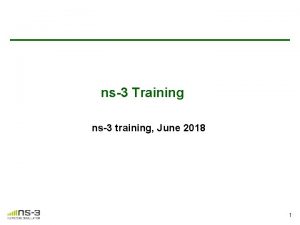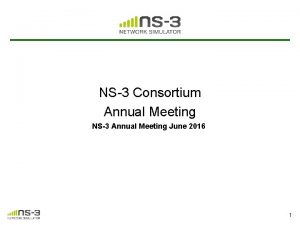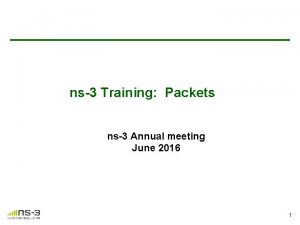NS3 System Concept Review Deployment and Intelligent Nanosatellite










































- Slides: 42

NS-3 System Concept Review Deployment and Intelligent Nanosatellite Operations (DINO) Presented by: Jennifer Michels and Jeffrey Parker

DINO’s Mission Statement The purpose of the student-led Deployment and Intelligent Nanosatellite Operations (DINO) mission is to determine cloud heights from space, evaluate the performance of intelligent operations, and assess deployment technologies for nanosatellites, which include a tether, memory composite hinges, and thinfilm solar arrays. 10/27/2021 DINO System Concept Review 2

Mission Features n n DINO is entirely designed, built, tested, operated, and managed by students The following supporters provide satellite components and mentoring: ¨ ¨ ¨ n Space Grant General Dynamics Interface Control Systems Micro. Sat Systems CU Faculty ¨ Composite Technology Development ¨ Jet Propulsion Laboratory ¨ Ball Aerospace ¨ Lockheed Martin DINO demonstrates an array of current technologies for nanosatellites 10/27/2021 DINO System Concept Review 3

Staff Dave Beckwith Elaine Hansen Chris Koehler Steve Wichman Organization Chart Project Management and Control Jen Michels (L) Jeff Parker ADCS Steve Stankevich (L) Jeff Parker Tim Shilling General Dynamics (I) C&DH Mike Li (L) Jen Michels Science Jessica Pipis (L) Mike Wong 10/27/2021 Systems Engineering Jeff Parker (L) Anthony Lowrey COMM Zach Allen (L) Mike Li NMSU (A) Software Cory Maccarrone Cameron Hatcher Nick Pulaski JPL (I) MOPS Steve Stankevich (L) Structures Tim Shilling (L) Anthony Lowrey Micro. Sat (I) CTD (I) DINO System Concept Review Power Mike Wong (L) Jen Michels Ball (I) Thermal Josh Stamps (L) Ball (I) 4

Science and Education Objectives n Stereoscopic imaging to determine cloud heights Thermal modeling of atmosphere ¨ Climate-prediction models ¨ Air traffic benefits ¨ n n Student leadership and training Active involvement of K-12 students 10/27/2021 DINO System Concept Review 5

Deployment Objectives n n Demonstration of thin-film solar array deployment Demonstration of thin-film solar cells as primary power source Demonstration of gravity-gradient tether deployment Simple deployment system using memory composite hinges 10/27/2021 DINO System Concept Review 6

Intelligent Operations Objectives n n Onboard evaluation of science and engineering data Autonomous response and rescheduling to optimize operations 10/27/2021 DINO System Concept Review 7

Mission Goals and Success Criteria n Goals ¨ Global cloud topography n (50%) groundtrack coverage 100% Deployment of all deployable structures ¨ Reliable autonomous rescheduling for a full day ¨ n Success Criteria Confirm one cloud height measurement ¨ 100% deployment of each memory composite hinge; 100% deployment of thin-film solar arrays, >50% deployment of tether. ¨ Demonstration of rescheduling a task with improved performance ¨ 10/27/2021 DINO System Concept Review 8

System Constraints n Stereoscopic Imaging ¨ Altitude 350 – 750 km ¨ Attitude determination and control to within ~10° yaw ¨ Passive attitude control to within ~ 5° nadir-pointing n Maximum Satellite Parameters ¨ 23. 75 cm radius ¨ 47. 5 cm height ¨ 25 kg mass ¨ 30 Watts power 10/27/2021 DINO System Concept Review 9

Subsystem Designs n n n n Structures & Deployables Power ADCS Thermal Communications EEDS: C&DH EEDS: Software Science 10/27/2021 DINO System Concept Review 10

Structures n Aluminum Iso-grid ¨ 6 Side-panels ¨ 2 End-panels n n n Launch Vehicle Interface (LVI) Integration and Test Fixture (ITF) interface ITF 10/27/2021 DINO System Concept Review 11

Structures Magnetometer & Torque Rods Power Sun Sensors Communications Imagers GPS Receiver Battery Iso Grid Structure End to End Data Systems (EEDS) 10/27/2021 DINO System Concept Review 12

Structures EMC Hinge Stowed Aero Fins Launch Interface Tether Tip Mass Stowed Thin-Film Solar Arrays Imagers EMC Hinge Antennas Thin-Film Solar Array DINO Earth Pointing Face 10/27/2021 DINO Stowed Configuration DINO System Concept Review 13

Deployables n 20 -m tether ¨ Deployment n Tip Mass Mechanism Tip Mass Payload Tether Material ¨ Camera ¨ Experiments 10/27/2021 DINO System Concept Review 14

Deployables n Memory-composite hinges ¨ Two aerofins ¨ Either single- or double -deployment ¨ 10 Watts, 1 minute 10/27/2021 DINO System Concept Review 15

Deployables n Foldable Integrated Thin-Film Stiffened (FITS) solar array deployment (Micro. Sat). n Deployment mechanism for FITS (CSGC). 10/27/2021 DINO System Concept Review 16

Power Solar Cells n Primary: thin-film solar arrays. ¨ n ~8% efficient Backup: body-mounted Top face, aerofin faces, leading edges ¨ ~20% efficient ¨ n Courtesy of Micro. Sat Systems Batteries n n Trade study on Ni. MH, Ni. Cd, and Li-Ion 12 to 14 V Spacecraft battery system Tip mass battery system Electrical Buses & Converters n n Peak-to-peak trackers Electrical buses ¨ n 10/27/2021 5 V and 12 V regulated buses Current monitoring DINO System Concept Review 17

ADCS Controllers n n n Sensors Passive gravity-gradient boom ¨ Radial stabilization ¨ Controlled deployment Active magnetic torque rods ¨ Yaw stabilization Passive aerofins ¨ Experimental yaw stabilization 10/27/2021 n Trade Study: GPS ¨ Sun sensors ¨ Limb sensors ¨ Magnetometer ¨ DINO System Concept Review 18

Thermal n Measurements ¨ n Passive ¨ ¨ ¨ n MLI blankets Surface Finishes Radiators Active ¨ n Thermisters Heaters for selected elements Thermal Modeling and Testing 10/27/2021 DINO System Concept Review 19

Communications n n n 3 CS radio: TH-D 7 Kenwood External TNC UHF-band uplink / VHF-band downlink ¨ Trade study on communication frequencies Antenna design trade study Wireless communication with tip mass experiments 10/27/2021 DINO System Concept Review 20

EEDS: C&DH n Power PC 823 e ¨ 64 MB SDRAM ¨ 16 MB Flash n n Ethernet connection for GSE Interface board 10/27/2021 DINO System Concept Review 21

EEDS: Software n n n n Trade study on Vx. Works or Linux operating systems 3 CS base software Subsystem modules Spacecraft Command Language (SCL) – ICS Inc. Onboard science data evaluation Continuous Automated Scheduling, Planning, Execution, and Replanning (CASPER) – JPL Command Logs 10/27/2021 DINO System Concept Review 22

Science n Trade Studies: ¨ One Camera n Less Complex n No yaw control requirements ¨ Two Cameras n Higher resolution n Better software testbed ¨ Serial vs. USB Connections 10/27/2021 DINO System Concept Review 23

Ground Support Equipment n n Electrical ¨ Ethernet with laptop ¨ Power supply with override ¨ Breakout box for main voltages ¨ Battery charging Mechanical ¨ Interface and Testing Fixture ¨ Storage and transportation box ¨ Hardware protection 10/27/2021 (GSE) Battery Charging Power Supply Override Breakout Box ITF DINO System Concept Review Laptop 24

Mission Operations Remote Ground Stations CU-Boulder MOCC NASA/USAF Centers Ground Images Security Checks Public Data Universities Planning, Scheduling, Commanding and Control DB On-site team Legend Science / Telemetry Command Requests Commands Processed Data 10/27/2021 DINO System Concept Review 25

Heritage n Spaceflight Heritage ¨ ¨ n ADCS sensors Thermisters, MLI blankets, radiators, heaters 3 CS / CX Experience ¨ ¨ ¨ ¨ Aluminum iso-grid structure Half of the ground support equipment components Peak-to-peak power trackers Triple-junction solar cells TH-D 7 Kenwood Power PC 823 e Software n n 10/27/2021 Vx. Works Base software with subsystem modules Spacecraft Command Language CASPER DINO System Concept Review 26

System Engineering Approach 10/27/2021 DINO System Concept Review 27

10/27/2021 DINO System Concept Review 28

10/27/2021 DINO System Concept Review 29

10/27/2021 DINO System Concept Review 30

10/27/2021 DINO System Concept Review 31

Risk Analysis and Contingency Plan n Three step process ¨ Step 1: Identify risks involved with all aspects of the program. ¨ Step 2: Analyze each risk. ¨ Step 3: Build a contingency plan based on the analysis of the risks. 10/27/2021 DINO System Concept Review 32

Step 1: Identify Risks n Satellite Building ¨ Requirements ¨ Availability n of hardware and software Schedule ¨ Milestones ¨ Long duration tasks ¨ Tasks dependencies ¨ Tasks with minimal or no slack time 10/27/2021 DINO System Concept Review 33

Step 1: Identify Risks n Resources ¨ Task dependence on a single human resource or scarce equipment ¨ Availability and timing of required equipment and training n Budget ¨ Stability of estimates or contract resources ¨ Promised donations 10/27/2021 DINO System Concept Review 34

Step 2: Risk Analysis n For each identified risk determine: ¨ Nature of the problem(s) that might occur ¨ Potential impact on the project ¨ Scenarios for the problems identified n Assign risk levels (High, Medium, Low) ¨ Look n n n 10/27/2021 at all factors Dependencies Probability of occurring Impact DINO System Concept Review 35

Step 3: Contingency Plans n n Create a contingency plan for any risk identified as High or Medium Schedule slack time for tasks with greater risks Find all the needed resources in advance of needing them For each risk define: ¨ Preventative action to reduce or remove the risk ¨ Person/Team responsible for the risk 10/27/2021 DINO System Concept Review 36

Safety Considerations n Personnel Safety: n Prevent Electrostatic Discharge ¨ Follow proper power-up procedures ¨ Safety-assured ground support equipment ¨ Safe transportation ¨ All students will participate in a safety course ¨ Work must be done in pairs, according to the buddy system. ¨ n Shuttle Safety: n Structure strong enough to withstand all vibrations and temperature during launch ¨ Assure no accidental deployments ¨ 10/27/2021 Satellite Safety: Integration Safety: Electrical plan of action ¨ Structural Considerations ¨ Student Regulations ¨ DINO System Concept Review 37

Student Involvement n DINO Team ¨ System n Concept Jennifer Michels, Jeffrey Parker, Anthony Lowrey, Byron Jones, Scott Miller ¨ Safety n 10/27/2021 Jennifer Michels, Jeffrey Parker, Anthony Lowrey, Ryan Olds, Greg Wormer, Anders Fornberg, Mike Kreig DINO System Concept Review 38

Education Focus n n DINO is designed, built, integrated, tested, operated, and managed by students. Advisors include: ¨ ¨ ¨ n n Space Grant General Dynamics Interface Control Systems Micro. Sat Systems CU Faculty ¨ Composite Technology Development ¨ Jet Propulsion Laboratory ¨ Ball Aerospace ¨ Lockheed Martin Space Grant outreach program for K-12 Image acquisition by K-12 students. 10/27/2021 DINO System Concept Review 39

Appendix A: Science n Stereoscopic cloud height determination Typical thunderhead on first pass 10/27/2021 Thunderhead 90 minutes later DINO System Concept Review 40

Appendix B: Mission Operations 10/27/2021 DINO System Concept Review 41

Appendix C: VMOCC 10/27/2021 DINO System Concept Review 42
 Unp nano
Unp nano Ns-3 tutorial
Ns-3 tutorial Ns3 tutorial
Ns3 tutorial Ns3 training
Ns3 training Lte full duplex
Lte full duplex Ns3 network simulator
Ns3 network simulator Ns3 training
Ns3 training Cubic or ctcp
Cubic or ctcp Ns3 training
Ns3 training Component diagram for hospital management system
Component diagram for hospital management system Deployment diagram notations
Deployment diagram notations Block diagram of mobile phone
Block diagram of mobile phone Horizontal deployment
Horizontal deployment Component diagram example
Component diagram example Deployment diagram for online voting system
Deployment diagram for online voting system Intelligent storage definition
Intelligent storage definition Intelligent storage definition
Intelligent storage definition Electric forces and fields concept review
Electric forces and fields concept review Csci2040
Csci2040 Difference between deployment and development
Difference between deployment and development Sales department structure
Sales department structure Power bi governance and deployment
Power bi governance and deployment Component and deployment diagram
Component and deployment diagram Intune deployment planning, design and implementation guide
Intune deployment planning, design and implementation guide Sales force structure
Sales force structure Komponen diagram
Komponen diagram What is this image
What is this image Differentiate ideal self from actual self
Differentiate ideal self from actual self Perbedaan selling concept dan marketing concept
Perbedaan selling concept dan marketing concept Decision support systems and intelligent systems
Decision support systems and intelligent systems Nice comparative degree
Nice comparative degree High comparative and superlative
High comparative and superlative Conventional computing and intelligent computing
Conventional computing and intelligent computing Concept review measuring motion answer key
Concept review measuring motion answer key Bow wave aircraft
Bow wave aircraft Proof of concept review
Proof of concept review Concept map of literature
Concept map of literature Amalgamation theory ap human geography
Amalgamation theory ap human geography Chapter review motion part a vocabulary review answer key
Chapter review motion part a vocabulary review answer key Uncontrollable spending ap gov
Uncontrollable spending ap gov Narrative review vs systematic review
Narrative review vs systematic review Narrative review vs systematic review
Narrative review vs systematic review Narrative review vs systematic review
Narrative review vs systematic review
